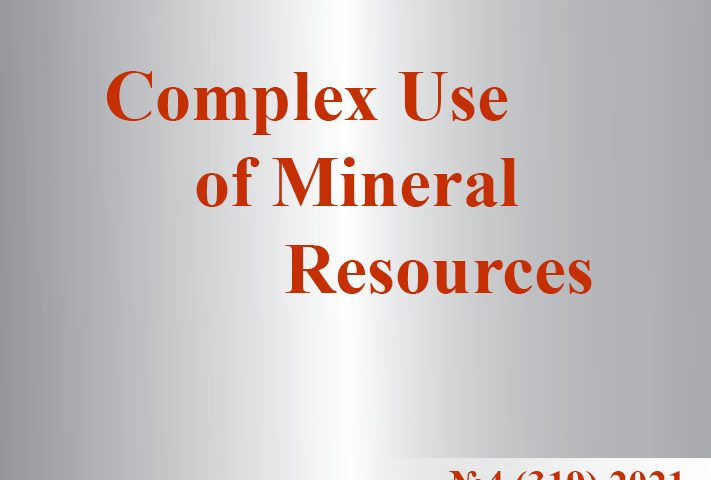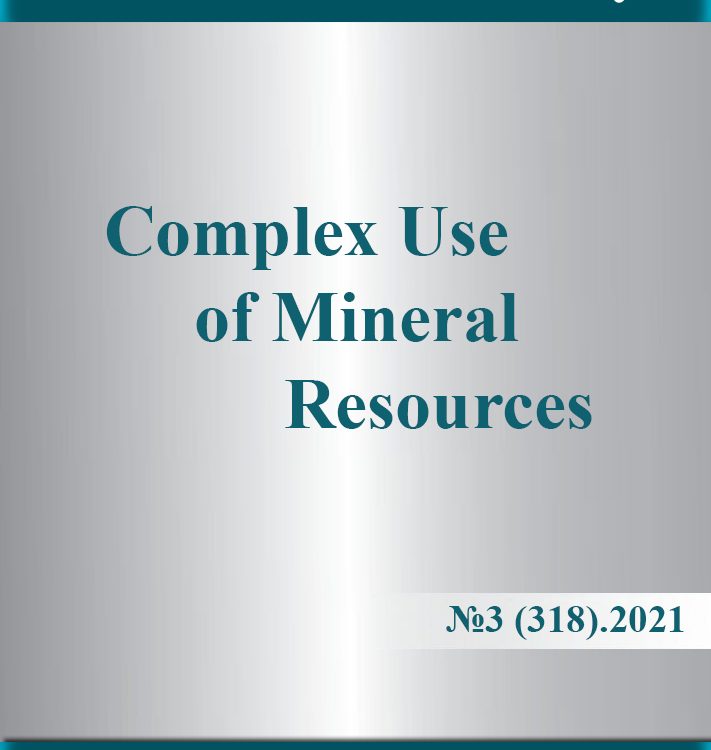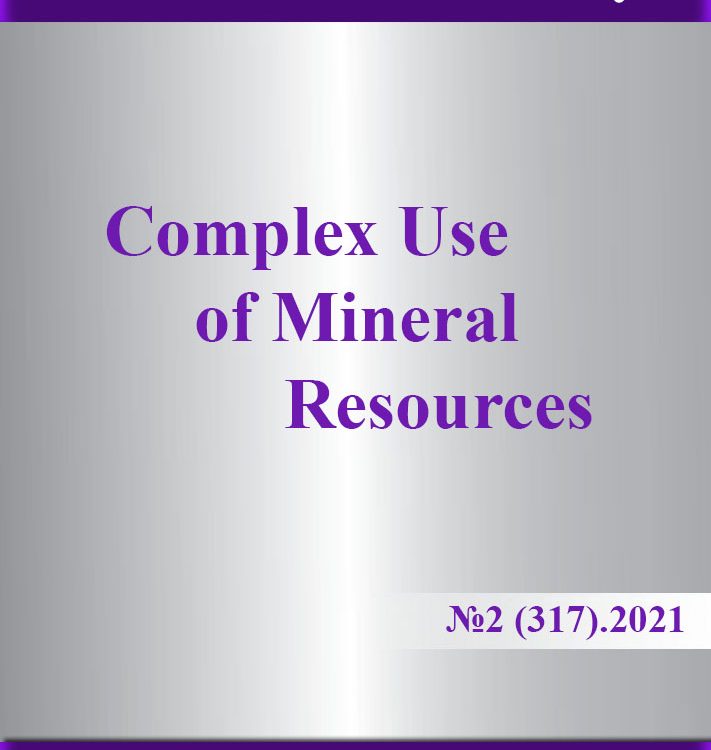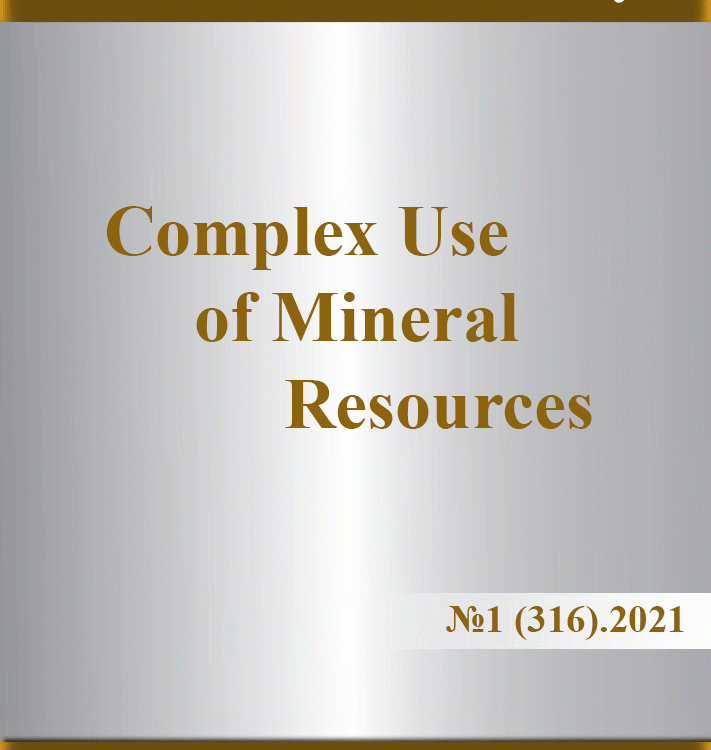Title: Kaolinite clays as a source of raw materials for the aluminum industry of the Republic of Kazakhstan
Authors: Kenzhaliyev B. K., Imangalieva L.M., Manapova A.I., Azlan M.N.
Abstract: Kaolinite clays can serve as an additional source of alumina in the Republic of Kazakhstan. The most promising is the Alekseevsky kaolinite deposit. To obtain high-quality kaolinite and quartzite products, it is necessary to develop special enrichment techniques, since no satisfactory results were achieved when using standard methods of gravitational enrichment of kaolinites. The paper presents the results of studies of the effect of preliminary chemical activation during the processing of kaolinite clays of the Alekseevsky deposit. Previously, the method of preliminary chemical activation of raw materials in a solution of sodium bicarbonate has proven itself well in the processing of various mineral raw materials. It was determined that during the preliminary chemical activation in a solution of sodium bicarbonate, changes occurred in the phase composition of the kaolinite fraction: the content of muscovite decreased almost twice; the phase of sodium aluminosilicate was formed. The dependence of the yield of Al2O3 in the kaolinite fraction on the temperature of chemical activation, duration, and the ratio of L:S and the concentration of the sodium bicarbonate solution during chemical activation. The optimal mode of preliminary chemical activation of kaolinite clay of the Alekseevsky deposit has been established: the temperature is 150 oC, the duration is 120 minutes and the concentration of sodium bicarbonate solution is 120 g/dm3. A basic technological scheme is proposed for the processing of kaolinite clays.
Keywords: кaolinite, quartzite, silicon module, chemical activation, chemical enrichment, product yield, technology.
Cite this article as: Kenzhaliyev B.K., Imangalieva L.M., Manapova A.I., Azlan M.N. (2021). Kaolinite clays as a source of raw materials for the aluminum industry of the Republic of Kazakhstan. Kompleksnoe Ispol’zovanie Mineral’nogo Syr’a = Complex Use of Mineral Resources. Volume 4, Issue 319, pp. 5-12. https://doi.org/10.31643/2021/6445.34
Title: Study of influence of the charge granulometric composition on the quality of burned anodes
Abstract: Many factors affect the quality of produced anodes: composition and grade of raw materials, recipe, technology, operating parameters, the granulometric composition of charge materials etc. The most significant influence is from the last factor. The article provides research results on the effect of fine fractions on the quality of anodes. The research object is charge of different granulometric composition used to produce anodes at the Kazakhstan Electrolysis plant in Pavlodar. Six types of anode mass with different granulometric composition were prepared for the experiment. The anode mass was made of petroleum coke, pitch, recycled anodes, and dust from filters and grinder produced during coke treatment. Several properties of the specimens were studied. In total, six specimens were made and, specimen № 4 drew particular attention. Its granulometric composition is as following: coarse fractions – 25 %, medium fractions – 20%, fine fractions (grinder dust) – 50 %, and filter dust – 5 %. The results showed that some specifications of anodes, like gas permeability and apparent density that affect anode consumption, are improved as the fineness of dust grinding. For instance, the addition of dust fraction in the charge increases anode density from 1.542 to 1.639 kilogram per cubic decimeters and decreases gas permeability from 1.01 to 0.78 nPm. In addition, the presence of dust fraction minimizes the porosity of the anode block. The results of the investigation help adjust the optimal recipe of anode mass to obtain high-quality anodes.
Keywords: anode mass, production of baked anodes, gas permeability, density, granulometric composition, fine fraction.
Cite this article as: Akizhayeva A.S. (2021), Study of influence of the charge granulometric composition on the quality of burned anodes. Kompleksnoe Ispol’zovanie Mineral’nogo Syr’a = Complex Use of Mineral Resources. 2021. Volume 4, Issue 319, pp. 13-18. https://doi.org/10.31643/2021/6445.35
Title: Investigation of degradation processes in perovskite under the influence of external factors
Authors: Zakhidov A.A., Zhamanbayeva G.T., Yar-Mukhamedova G.Sh.
Abstract: The article describes a number of new fundamental knowledge about mechanisms of degradation processes occurring in photoactive perovskite materials based on complex lead halides and solar cells based on them, modern methods and approaches to increasing the operational stability of perovskite photovoltaic devices are considered. The revealed paths of degradation processes occurring in complex metal halides (lead and tin) under the influence of light and elevated temperatures are important for further developments in the field of creating highly efficient and stable perovskite solar cells of a new generation. The investigated models of degradation are described both under the action of moisture and as a result of radiation ionization processes. The importance of solving the Dexter-Varley paradox, which takes into account the competition between the processes of displacement of IS0 states, as well as the delocalization of the resulting hole in the valence band, is emphasized. It was shown that by changing the force of pressure of the tape on the perovskite film, it was possible to achieve the maximum values of the light conversion efficiency of about 12.7%. It was found that the presence of charge carriers in the form of polarons can significantly affect the assessment of the degradation efficiency towards its increase. The data obtained can radically change the traditional ideas about the efficiency of photochemical reactions.
Keywords: perovskite materials, degradation processes, encapsulation.
Cite this article as: Zakhidov A.A., Zhamanbayeva G.T., Yar-Mukhamedova G.Sh. (2021), Investigation of degradation processes in perovskite under the influence of external factors. Kompleksnoe Ispol’zovanie Mineral’nogo Syr’a = Complex Use of Mineral Resources. Volume 4, Issue 319, pp. 19-24. https://doi.org/10.31643/2021/6445.36
Title: Prospects for use of chlorine-containing leaching solutions for extraction of associated useful components from spent ores of uranium deposits
Authors: Duisebayeva T.S., Arbuz A. S.
Abstract: Work aimed at diversification of production through the additional extraction of associated useful components at uranium mines. The peculiarity of the work carried out is the additional processing of spent uranium mines at the existing ones using the existing production infrastructure for the extraction of associated useful components. The technology of underground leaching is well developed for uranium deposits. The leaching of associated useful components differs from the leaching of uranium only in the reagents used, and they are fundamentally similar to the method of underground-borehole leaching. Even if there are associated components in the uranium-bearing sands with a content of less than 1 g/t, up to 0.1 g/t production can be profitable. The use of ready-made infrastructure of uranium mines on spent blocks of deposits allows us to expect positive economic profitability in the future.
Keywords: uranium mines, associated valuable metals, associated useful components, underground well leaching, productive solution, chlorine-containing solutions.
Cite this article as: Duisebayeva T.S., Arbuz A.S. (2021), Prospects for use of chlorine-containing leaching solutions for extraction of associated useful components from spent ores of uranium deposits. Kompleksnoe Ispol’zovanie Mineral’nogo Syr’a = Complex Use of Mineral Resources, Volume 4, Issue 319, pp. 25-31. https://doi.org/10.31643/2021/6445.37
Title: Pitting resistance evaluation of ternary Ni-Cr-Mo alloys in flue gas environment
Authors: Kemelzhanova A., Mukashev K., Muradov A., Lampke Th., Mussabek G.
Abstract: After the appearance of pitting corrosion, the corrosion rate reaches very high values, which leads to a deterioration in the quality of the product in a short time. It may happen that the pitting does not continue its penetrating effect: if there are no necessary conditions for its growth, a pitting of greater activity is not formed, which will absorb all the current supplied from the area surrounding the cathode. Results of potenciodynamic investigations of four Ni‐base alloys are presented. The tests were conducted in 1 percent sulphuric acid, containing 0.2 percent chlorides at temperature 353K. Gravimetric test, performed in the same conditions, revealed excellent properties of alloy signed A3. Pitting corrosion of alloy A4 at the test conditions after long exposure at 353K was observed and was confirmed by the applied tests. The multiple anodic polarization (MAP) method is proposed to control alloys’ susceptibility to pitting corrosion.
Keywords: pitting, alloy, anodic polarization.
Cite this article as: Kemelzhanova A., Mukashev K., Muradov A., Lampke Th., Mussabek G. Pitting resistance evaluation of ternary ni-cr-mo alloys in flue gas environment. Kompleksnoe Ispol’zovanie Mineral’nogo Syr’a. = Complex Use of Mineral Resources. 2021, Volume 4, Issue 319, pp. 32-36. https://doi.org/10.31643/2021/6445.38
Title: Horizontal wells as a means of intensification of oil production
Authors: Jalalov G.E., Kunayeva G.Y., Bayamirova R. Y.
Abstract: Numerous experimental and field studies have established that during the development of oil and gas fields, there are deformations of rocks that occur due to changes in reservoir pressure. It is established that with a drop in reservoir pressure, the volume of the pore space of the formation decreases due to the elastic expansion of the rock grains and an increase in compressive forces transmitted to the skeleton from the masses of the overlying rocks. As a result, there is a change in the deformation processes in the porous medium, accompanied by a decrease in its porosity and permeability, and a more significant change, compared with the porosity of the formation, is the permeability under one and the same pressure change. The manifestation of these anomalies in reservoir conditions, which cause nonlinear effects, can significantly affect the entire process of reservoir development and lead to various qualitative and quantitative discrepancies between the observed facts and the indicators that were calculated.
Keywords: horizontal wells, productive formation, drilling, horizontal trunk.
Cite this article as: Jalalov G.E., Kunayeva G.Y., Bayamirova R.Y. Horizontal wells as a means of intensification of oil production. Kompleksnoe Ispol’zovanie Mineral’nogo Syr’a = Complex Use of Mineral Resources. 2021, Volume 4, Issue 319, pp. 37-47. https://doi.org/10.31643/2021/6445.39
Title: Study of rare earth elements in the coals of the Shubarkol deposit
Authors: Amangeldykyzy A., Kopobayeva A. N., Askarova N. S., Ozhigin D.S., Portnov V. S.
Abstract: The work studies mineralogical and geochemical features of the Jurassic coals of the Shubarkol deposit. The samples were examined using the method of scanning electron microscopy (SEM-EDX) Hitachi S-3400N, which was carried out at the Uranium Geology Research and Development Center at the Department of Geoecology and Geochemistry of TPU. Coal geochemistry was studied by instrumental neutron activation analysis (INAA) at the nuclear geochemical laboratory of the Department of Geoecology and Geochemistry of National Research Tomsk Polytechnic University (TPU). The choice of this object of study was determined by the tasks of research including the study of the patterns of accumulation of abnormal concentrations of REE, the effect of various factors of the geological environment on the levels of their accumulation in coals, as well as the conditions of its concentration and forms of occurrence in coals to expand the mineral resource base of Kazakhstan for rare earth elements. According to the results of scanning microscopic analysis, aluminosilicates, sulfides and sulfates with inclusions of microparticles of rare and rare earth elements were found in the composition of the Shubarkol deposit coals. According to the INNA results, abnormal concentrations of Sc, Ta, Nb, Hf, Zr, Ba, Sr, Ce and REE were found. Weathering processes led mainly to the loss and redistribution of REE in the coal seams of the Shubarkol deposit, which in turn led to increasing the content of rare earth elements from the bottom up the section. As a result of the action of multiple processes, increased concentrations of rare earth metals, mainly of the yttrium group, were formed. The absence of negative europium anomaly was determined, which confirms the original rocks composition peculiarity. The maximum contents of rare-earth metals are confined to weathered coals; for the medium-heavy group (Nd, PM, Sm, Eu), they are almost a hundredfold higher than the clarke in the upper continental crust. The tenfold excess of the clarke for elements from Gd to Lu was found in clayey sandstones and siltstones; for the rest of the rocks of the deposit the excess over the clarke is significantly lower. It was found that the coals of the deposit belong to the H-type and L-type of REE distribution. During the formation of oxidized H-type coals, clayey matter of terrigenous ash predominated as a carrier of REE, while unoxidized L-type coals were formed with the introduction of REE into the coal accumulation basin mainly in the composition of clay minerals and LREE-phosphates. Here the main source of REE was apparently the weathering crust over acidic rocks.
Keywords: coal, Shubarkol, rare earth elements, mineralogy, geochemistry.
Cite this article as: Amangeldykyzy A., Kopobayeva A.N., Askarova N. S., Ozhigin D.S., Portnov V.S. (2021). Study of rare earth elements in the coals of the Shubarkol deposit. Kompleksnoe Ispol’zovanie Mineral’nogo Syr’a = Complex Use of Mineral Resources. Volume 4, Issue 319, pp. 48-56. https://doi.org/10.31643/2021/6445.40
Title: On the possibility to process copper-molybdenum ore using a combined flotation reagent
Authors: Semushkina L.V., Abdykirova G.Zh., Turysbekov D.K., Narbekova S.M., Kaldybayeva Zh.A.
Abstract: The article presents the results of laboratory studies on ore flotation of copper-molybdenum deposits in the East Kazakhstan region of Kazakhstan using a combined reagent. It is required to use new beneficiation methods and flotation reagents to increase the efficiency of flotation of ore minerals to improve the processing of finely disseminated ores. The problem can be solved by using a combination of different collectors. The objective of the research is to increase the recovery of copper and molybdenum during flotation of copper-molybdenum ore using a combined reagent. The studied ore sample contains 0.42% copper; 0.009% molybdenum. A combination of sodium butyl xanthate, TS-100 thionocarbamate, and reaflot in a ratio, in %: 15: 3: 1, was used as a combined flotation reagent. The combined flotation reagent was preliminarily passed through an ultrasonic homogenizer JY96-IIN to obtain a reagent microemulsion before flotation. The optimum dispersion time for the combined flotation reagent is 60 seconds. At the same time, 99.4% are microemulsion particles with a particle size of fewer than 3.7 microns. The use of a combined reagent microemulsion increases the extraction of copper into the copper-molybdenum concentrate by 3.69%, and the extraction of molybdenum by 6.05%. The copper content in the copper-molybdenum concentrate increases by 1.26%. The copper content in the flotation tailings decreases from 0.07 to 0.056%. The consumption of the combined reagent is reduced by 15% in comparison with the basic butyl xanthate.
Keywords: flotation, copper-molybdenum ore, flotation reagent, dispersion, concentrate, extraction.
Cite this article as: Semushkina L.V., Abdykirova G.Zh., Turysbekov D.K., Narbekova S.M., Kaldybayeva Zh.A. (2021). On the possibility to process copper-molybdenum ore using a combined flotation reagent. Kompleksnoe Ispol’zovanie Mineral’nogo Syr’a = Complex Use of Mineral Resources. Volume 4, Issue 319, pp. 57-64. https://doi.org/10.31643/2021/6445.41
Title: Specific features of uranyl ions extraction by interpolymer system based on polyacrylic acid and polyethyleneimine hydrogels
Authors: Utesheva A.A., Grazulevicius J.V.
Abstract: Uranyl ions sorption of by interpolymer system consisting of polyacrylic acid hydrogel (hPAA) and polyethyleneimine hydrogel (hPEI) has been studied. Rate of uranyl ions extraction by the initial polymers and interpolymer system hPAA-hPEI, polymeric chain binding rate and dynamic exchange capacity of initial polymers and interpolymer system hPAA-hPEI were calculated. Based on obtained outcomes it was found that area of maximum rate of uranyl ions extraction is within the ratios of 67%hPAA:33%hPEI and 33%hPAA:67%hPEI. Maximum uranyl ions extraction rate after 48 hours of hydrogels remote interaction was 90.0 %, when polymeric chain binding rate was 9.1 % and dynamic exchange capacity was 1.14 mmol/g. Rate of uranyl ions extraction by the initial polymer hydrogels 100 % hPAA and 100 % hPEI was 68.0 % and 52.0%. Obtained outcomes showed changes of initial polymeric hydrogels sorption properties in intergel system leading to functional groups obtaining higher reactive ability, which makes it possible to use them for further development of highly efficient uranyl ions extraction sorption technology.
Keywords: hydrogels, interpolymer systems, sorption, polyacrylic acid, polyethylenimine, uranyl ion.
Cite this article as: Utesheva A.A., Grazulevicius J.V. Specific features of uranyl ions extraction by interpolymer system based on polyacrylic acid and polyethyleneimine hydrogels. Kompleksnoe Ispol’zovanie Mineral’nogo Syr’a = Complex Use of Mineral Resources. 2021, Volume 4, Issue 319, pp. 65-71. https://doi.org/10.31643/2021/6445.42
Title: Study of the mechanism of pre-burned ash leaching by hydrochloric acid
Authors: Dosmukhamedov N.K., Zholdasbay E.E., Daruesh G.S., Argyn A.A., Kurmanseitov M.B.
Abstract: The use of hydrochloric acid for processing aluminum-containing raw materials has a number of advantages over other acids, which include: easy decomposition of aluminum compounds with the transfer of aluminum into solution; low solubility of silica in HCl, the possibility of complete separation of the solid residue without significant losses of acid, etc. The paper considers the possibility of using the method for processing ash and slag dumps accumulated in large volumes in the country. Based on the thermodynamic analysis of reactions of interaction between ash components and hydrochloric acid, the behavior of aluminum, iron and nonferrous metal compounds during leaching is studied. It was shown that the preliminary roasting of ash with calcium chloride provides a high extraction of aluminum in the solution from the cinder. Based on experimental studies, the influence of time, temperature and acid consumption on the degree of aluminum extraction into the solution has been established. At optimal conditions of leaching conducted at S:L = 1:3, T = 60 ºC, τ = 60 min extraction of aluminum in a solution as chloride amounted to 99.92 %. At the same time the extraction of silica in solid sediment due to the maximum transfer of impurities in the solution was 99.8 %. The mechanism of the leaching process is proposed. The values of activation energy and the order of the reaction, indicating the complex 3-step character of the reactions, have been calculated. It is established that the limiting stage during leaching is the dissolution of anorthite.
Keywords: carbon black, leaching, hydrochloric acid, process mechanism, time, temperature, extraction, activation energy.
Cite this article as: Dosmukhamedov N.K., Zholdasbay E.E., Daruesh G.S., Argyn A.A., Kurmanseitov M.B. (2021). Study of the mechanism of pre-burned ash leaching by hydrochloric acid. Kompleksnoe Ispol’zovanie Mineral’nogo Syr’a = Complex Use of Mineral Resources. Volume 4, Issue 319, pp. 72-80. https://doi.org/10.31643/2021/6445.43
Title: Modification of microstructure of LD slag for recovery of hybrid flux material
Authors: Dilip M., Rajendra K.R.
Abstract: The Basic Oxygen Furnace steel making process produces BOF slag (LD slag) at a rate of about 125 kg/t. The LD slag contains about 18% Fe in wustite and dicalcium ferrite and about 45% CaO. These minerals are an excellent source of alternative flux material for the steel industry. Through slag modification and in-depth characterization studies, investigations were carried out to develop a material that could be utilized as an alternative flux material. Detailed characterization studies were conducted using SEM-EPMA and XRD to identify the changes in the crystal structure, phase distribution, grain size and liberation size of minerals. The grain size of phases was found to be between 10-150 µm for normally cooled slag and 20-250 µm for slowly cooled slag. It was also shown that slow cooling promotes the formation of an additional phase which is essentially the dicalcium silicate phase (C2S) with some amounts of FeO and MgO in the crystal lattice. Overall, it was observed that about 50% of the LD slag could be recovered as alternative flux material containing approximately 30% CaO and 30% Fe content. This alternative flux material is an excellent source of material for use in steel industries because of its low melting slag formation.
Keywords: LD slag, сharacterization, hybrid flux, cooling rate, microstructure.
Cite this article as: Dilip M., Rajendra K.R. (2021). Modification of microstructure of LD slag for recovery of hybrid flux material. Kompleksnoe Ispol’zovanie Mineral’nogo Syr’a = Complex Use of Mineral Resources. Volume 4, Issue 319, pp. 81-93. https://doi.org/10.31643/2021/6445.44





